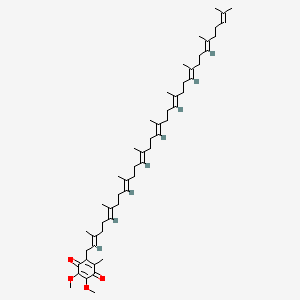| Authors | Title | Published | Journal | PubMed Link |
|---|---|---|---|---|
| Huertas JR et al. | Changes in mitochondrial and microsomal rat liver coenzyme Q9 and Q10 content induced by dietary fat and endogenous lipid peroxidation. | 1991 | FEBS Lett. | pmid:1879539 |
| Matsura T et al. | Changes in the content and intracellular distribution of coenzyme Q homologs in rabbit liver during growth. | 1991 | Biochim. Biophys. Acta | pmid:2049392 |
| Meerson FZ et al. | [Cardioprotective effect of combined use of coenzyme Q9 and cyclohexyladenosine in ischemia, reperfusion and acute myocardial infarction]. | 1991 | Kardiologiia | pmid:1921136 |
| Fuchs J et al. | Dermatologic antioxidant therapy may be warranted to prevent ultraviolet induced skin damage. | 1990 | Adv. Exp. Med. Biol. | pmid:2244536 |
| Vinogradova LF et al. | [Antioxidant activity of ubiquinone-9 and its combinations with vitamin E and sodium selenite in toxic lesions of the liver]. | 1989 Jan-Feb | Farmakol Toksikol | pmid:2540027 |
| Nakase T and Suzuki M | Sporobolomyces yuccicola, a new species of ballistosporous yeast equipped with ubiquinone-9. | 1988 | Antonie Van Leeuwenhoek | pmid:3389771 |
| Viljoen BC et al. | The significance of long-chain fatty acid composition and other phenotypic characteristics in determining relationships among some Pichia and Candida species. | 1988 | J. Gen. Microbiol. | pmid:3246589 |
| Vinogradova LF et al. | [Effect of ubiquinone-9 on the blood coagulation system]. | 1986 May-Jun | Farmakol Toksikol | pmid:3720936 |
| Kamei M et al. | The distribution and content of ubiquinone in foods. | 1986 | Int J Vitam Nutr Res | pmid:3710719 |
| KolomiÄtseva IK et al. | [Therapeutic effect of vegetable oils and ubiquinone-9 on radiation injuries]. | 1985 Jan-Feb | Radiobiologiia | pmid:4038806 |
Coenzyme Q9
Coenzyme q9 is a lipid of Prenol Lipids (PR) class. The involved functions are known as Diastasis, Phosphorylation and Cardiac function.
Cross Reference
Introduction
To understand associated biological information of Coenzyme Q9, we collected biological information of abnormalities, associated pathways, cellular/molecular locations, biological functions, related genes/proteins, lipids and common seen animal/experimental models with organized paragraphs from literatures.
What diseases are associated with Coenzyme Q9?
There are no associated biomedical information in the current reference collection.
No disease MeSH terms mapped to the current reference collection.
PubChem Associated disorders and diseases
What pathways are associated with Coenzyme Q9
There are no associated biomedical information in the current reference collection.
PubChem Biomolecular Interactions and Pathways
Link to PubChem Biomolecular Interactions and PathwaysWhat cellular locations are associated with Coenzyme Q9?
There are no associated biomedical information in the current reference collection.
What functions are associated with Coenzyme Q9?
Related references are published most in these journals:
| Function | Cross reference | Weighted score | Related literatures |
|---|
What lipids are associated with Coenzyme Q9?
There are no associated biomedical information in the current reference collection.
What genes are associated with Coenzyme Q9?
There are no associated biomedical information in the current reference collection.
What common seen animal models are associated with Coenzyme Q9?
There are no associated biomedical information in the current reference collection.
